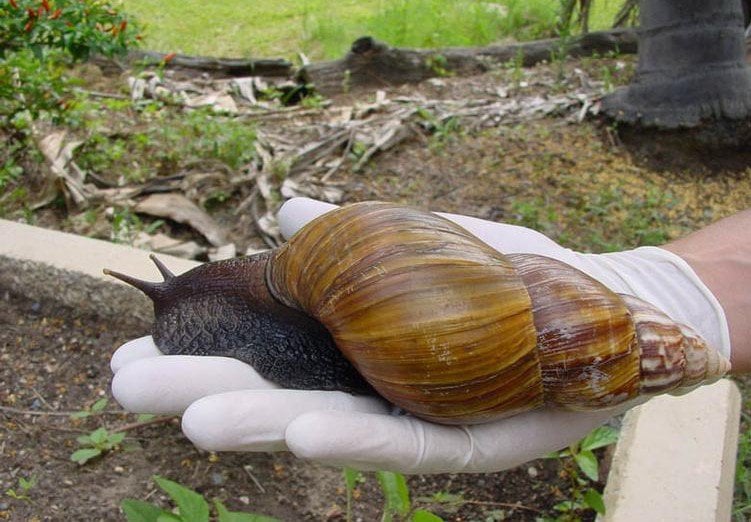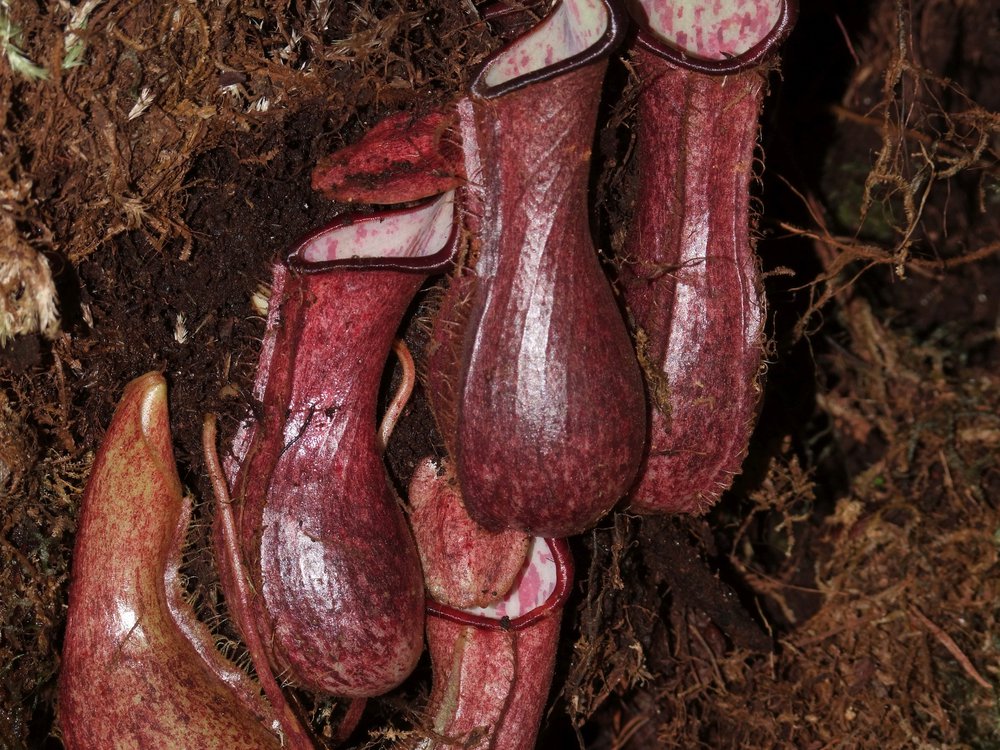SEPTEMBER 20, 2022
Florida's Battle To Eradicate The Giant African Land Snail Continues

The giant African land snail (GALS) has returned to Florida for a third time. The invasive species was first detected in the state in 1969. It took seven years and $1 million to get rid of them. The gastropods reappeared in 2011 and were eradicated in 2021 at a cost of $23 million. On June 23, 2022, Florida officials reported that the snails had been found in the New Port Richey area of Pasco County.
To stop the snails from spreading to other areas, officials have asked Pasco County residents to refrain from moving any soil or yard waste and to report any sightings to a special hotline. Specially-trained dogs have also been brought in to sniff out the snails. The areas where the mollusks have been found will be treated with a special pesticide for 18 months. Florida officials also intend to monitor the sites for two years after the last snail has been found.

The various measures to eradicate the snails may seem excessive. However, the giant African land snails are one of the most destructive snails in the world. The fist-sized mollusks are native to East Africa but can also be found in Hawaii and the Caribbean. The voracious eaters consume over 500 plant and tree species. While they prefer to eat fruits and vegetables like beans, peas, cucumbers, and melons, the animals are not fussy. They will munch on ornamental plants, tree bark, and even paint and stucco on houses! The animals also pose a serious health risk to humans by carrying the parasite rat lungworm, known to cause meningitis. The snails multiply rapidly, producing about 1,200 eggs in a single year. This makes it challenging to control their population.

Greg Hodges, the assistant director of the state's division of plant industry, says the latest specimens differ from the ones previously found. They have light cream-colored bodies with a dark, mottled brown shell.
"The populations that we dealt with in the previous two eradications had dark gray to brown bodies," he explained. "This cream-colored phenotype is very common in the pet trade in Europe and has been intercepted here in Florida previously with the illegal pet trade."
The officials are not sure how the snails got here this time. But Florida Agriculture Commissioner Nikki Fried is confident the state will eventually get rid of them.
"Because agriculture is such a prominent part of our economics in the state, it is so imperative we get in front of these things immediately," Fried said at her July 7, 2022 press briefing. "Let me assure you: We will eradicate these snails. We have done it twice before, and we will do it again – it is not a question of if, it's just when."
Resources: Fdacs.gov, Smithsonianmag.com, euronews.com
SEPTEMBER 6, 2022
The September 11, 2001 Terrorist Attacks

On September 11, 2022, Americans will mark the 21st anniversary of the deadliest terrorist attacks in US history. The unprovoked act of violence was planned and executed by members of the Islamic extremist organization al-Qaeda. The tragedy resulted in the deaths of 2,977 innocent people and altered life as we knew it forever.
What happened on September 11, 2001?
On September 11, 2001, nineteen terrorists split into four groups, each with a trained pilot, and took control of four commercial flights. They included United Flight 93 from New Jersey, American Flight 77 from Washington, DC, and United Flight 175 and American Flight 11 from Boston. The aircraft were headed cross-country to Los Angeles or San Francisco. This ensured they had enough fuel to cause the maximum possible damage.

Passengers aboard the airplanes knew they had been hijacked shortly after takeoff. However, the rest of the world remained unaware of the situation until 8:46 AM (EST). That's when American Flight 11 was seen heading towards New York City's tallest buildings — the World Trade Center's (WTC) Twin Towers. Before anyone could react, the aircraft struck the North Tower, creating a massive impact hole from the 93rd to the 99th floor.
Experts initially thought the crash was caused by pilot error or airplane malfunction. However, that notion changed when United Flight 175 crashed into WTC's South Tower at 9:03 AM (EST). About half an hour later, at 9:37 AM (EST), American flight 77 hit the Pentagon in Virginia. Shortly after that, United Flight 93 crash-landed in an empty field in Somerset County, Pennsylvania. It was evident that the US had suffered a series of well-orchestrated terrorist attacks.
The aftermath of the attacks
The intense fires, caused by the fueled airplanes crashing into the buildings, weakened the steel support trusses that attached the WTC Twin Towers' 110 floors to the building's exterior. This, together with the aircraft's initial impact hole, caused both towers to crumble into giant heaps of cement and steel in less than two hours. While the estimated 18,000 survivors in the WTC complex had been safely evacuated by then, many first responders were not as lucky.

While the Pentagon building survived the crash, the aircraft's initial impact killed 184 people. The death toll would have been even higher if the brave passengers and crew aboard United Flight 93 — destined for the US Capitol building in Washington, DC — had not forced the aircraft to crash in Pennsylvania.
What has happened since?
"Ground Zero," as it is now called, boasts four new towers. The flagship is the gleaming One World Trade Center, or "Freedom Tower." Standing at a symbolic 1,776 feet (541 meters) high, it is the tallest building in New York City and the entire Western Hemisphere. Adjacent to the Freedom Tower lies an elegant memorial featuring twin reflecting pools with the names of all the 9/11 victims etched into the bronze-paneled edges. The National September 11 Museum and Memorial built alongside features several artifacts from the tragic day.

The Pentagon has built 184 illuminated stainless steel benches to honor the 125 government employees and 59 crew members and passengers of American Flight 77 who died. In Somerset County, visitors can view exhibits commemorating the 9/11 tragedy at the Flight 93 National Memorial. They can also hear recordings of messages left to loved ones by the passengers and crew before it crashed.
September 11, 2001, was one of the darkest days in US history and will never be forgotten. However, it has also made Americans more resilient and determined to live without fear. This September 11 — or Patriot Day — take a few minutes to honor the thousands of innocent lives lost during that difficult time.
Resources: Wikipedia.org, 9/11memorial.org, History.com
SEPTEMBER 7, 2022
This Carnivorous Plant Traps Prey Underground

The carnivorous pitcher plants obtain nutrition by luring unsuspecting insects inside their unique jug-shaped leaves and devouring them. However, the brightly-colored "pitfall traps" are usually set above the ground. Now, researchers have found a new species that grows its prey-trapping contraptions underground to capture subterranean bugs like ants, mites, and beetles.
Biologist Martin Dančák and his team stumbled upon the unusual plant while exploring a remote mountain region in Borneo, Indonesia. The scientists noticed foliage that resembled pitcher plants. However, none sported the namesake leaves. The mystery was solved after a researcher found a handful of maroon pitchers under the moss at the base of a tree. In a nod to the concealed pitchers, the team named the species Nepenthes pudica (N.pudica) — the Latin word for bashful or shy.

The underground pitchers are sturdier and have thicker walls than their above-ground counterparts. This enables them to push the soil apart as they develop. The researchers speculate that burying the structures underground may protect the plants in their dry habitat, which is about 4,265 feet (1,300 meters) above sea level. It may also give the plants easier access to burrowing insects.
Dančák and his team, who published their findings in the journal PhytoKeys on June 23, 2022, maintain that the N. pudica is the first discovery of its kind. Three other groups of carnivorous plants that trap underground prey have been previously found. However, they all use different trapping techniques. Also, unlike the N. pudica, they can snare only minuscule organisms.
The scientists want the N. pudica, which can only be found in a small area, to be classified as critically endangered and protected. They hope that the discovery will highlight the urgent need to preserve the biodiverse Borneo rainforests, which are being cut down at a rapid pace to develop palm oil plantations.
Resources: nhm.ac.uk, Smithsonianmag.com, CNN.com
SEPTEMBER 22, 2022
European Drought Reveals Historical Treasures

Europe experienced its hottest summer in recorded history in 2022. The high temperatures and arid weather dried up bodies of water, destroyed crops, and sparked several wildfires. The only silver lining? The extreme weather dropped water levels low enough to expose long-lost artifacts from the past.
Serbia
In Serbia, the receding water level in the Danube River — Europe's second largest river — has revealed more than twenty Nazi German warships full of ammunition and explosive devices. The exposed World War II vessels are just a sample of the hundreds deliberately sunk by the Germans as they tried to flee from the advancing Soviet troops in 1944.
Spain
In central Spain, the drought has helped reveal the Dolmen of Guadalperal, a prehistoric circle of stones dating back to 5000 BCE. The ancient monument, nicknamed the "Spanish Stonehenge," was excavated by German archaeologist Hugo Obermaier in 1926. In 1963, the Spanish government flooded the area to build the now-standing Valdecañas reservoir. The recent drought has dropped the reservoir's water level to 23 percent capacity, allowing historians to catch a glimpse of the ancient relic.
Enrique Cedillo, an archaeologist at Complutense University of Madrid, told Reuters, "It's a surprise…a rare opportunity to be able to access it."
Germany and the Czech Republic

The dry banks of Germany's Rhine River and the Czech Republic's Elbe River have uncovered the so-called "hunger stones." The engraved stones, which range in date from 1947 to as recent as 2018, commemorate famine and other hardships. Some rocks are inscribed with just dates and initials. Others feature dire messages, such as "If you see me, then weep," and "When this goes under, life will become more colorful again."
Resources: Smithsonianmag.com,euronews.com, Zenger.news
SEPTEMBER 14, 2022
Rare 17th Century Shipwreck Discovered In The Baltic Sea

A local waterway and shipping authority was conducting a routine measurement in northern Germany’s Trave River when they stumbled upon a rare piece of history — a 17th-century shipwreck. Researchers from Kiel University, who revealed the find on July 26, 2022, believe the ship sank during the end of the Hanseatic period. This refers to the time between the 13th to 17th centuries when a network of 190 cities in 16 Northern European countries dominated maritime trade in the Baltic Sea.
"Independent dating of the ship's timbers in three different laboratories revealed that the ship must have been constructed in the mid-17th century," said Dr. Fritz Jürgens of the Institute of Prehistoric and Protohistoric Archaeology at Kiel University. “You always hope to make a find like this, and suddenly you have one right before your eyes."

All that remains of the vessel are some of its wooden beams and large parts of the cargo. The researchers identified the vessel as a fluyt – a single-masted Dutch cargo ship. Measuring between 66 and 82 feet (20 and 25 meters) long, the medium-sized cargo vessels were commonly used to transport goods across the Baltic Sea.
The ship was carrying quicklime — used in building construction — from Scandinavia to Germany. Of the 150 barrels found, 70 remained on board the vessel, while the other 80 were scattered on the ocean floor nearby. This suggests the boat did not capsize. Instead, it may have sunk after being damaged while trying to make a bend in the Trave River.

Underwater archeologists, who have been studying the wreck since July 2021, say the ship is eroding rapidly, and its exposed sections are infested with shipworms. They warn that the precious artifact will be forever lost if no protective measures are taken. The Kiel University researchers are currently working with the city of Lübeck and other institutions to find a way to salvage the wreck from the river and preserve it for future generations.
Resources: uni-kiel.de, DW.com,Gizmodo.com
SEPTEMBER 13, 2022
Remembering Queen Elizabeth II

Queen Elizabeth II, the United Kingdom's longest-serving monarch, died at Balmoral Castle in Scotland on September 8, 2022. She was 96. Her historic 70-year reign spanned several wars, a pandemic, 15 British prime ministers, and 14 US Presidents! Her eldest son, Prince Charles, was sworn in as King of England on September 10, 2022.
Queen Elizabeth II was born in London as Princess Elizabeth Alexandra Mary on April 21, 1926. She was the first child of Prince Albert and Elizabeth Bowes-Lyon (later King George VI and Queen Elizabeth). The young princess was just 13 when World War II broke out on September 1, 1939. But her youth did not stop her from contributing to the British war efforts.

On October 13, 1940 — a month after Germany's intense attack on the UK began — Elizabeth appeared on BBC's The Children's Hour to comfort kids living away from home during the war. The future queen enlisted in the women's branch of the British military as second lieutenant in 1945. She served as a driver and mechanic and was later promoted to a Junior Commander, the UK equivalent of a Captain in the US military.
In 1947, Elizabeth married Lieutenant Philip Mountbatten, a former prince of Greece and Denmark, at Westminster Abbey in London. The couple had four children: Charles in 1948, Anne in 1950, Andrew in 1960, and Edward in 1964.
YOUTUBE
YOUTUBE
Over the course of her 70-year-reign, the British monarch visited 117 countries and hosted more than 100 international heads of state in the UK. Her historic visit to Germany in 1965 was the first by a British sovereign in 52 years. It symbolized the reconciliation of the two nations after World War II.
The Queen also witnessed the dissolution of the British Empire in the decades following World War II. When Elizabeth came to the throne, Britain commanded over 70 overseas territories. At the time of her death, the monarch was recognized as the Head of State by just 15 Commonwealth countries. The voluntary political association comprises former British colonies including Australia and Canada.

In 2015, Queen Elizabeth II broke Queen Victoria's record as the longest-serving British monarch (63 years). Two years later, she became the first British sovereign to celebrate a Sapphire Jubilee — 65 years on the throne. In February 2022, the Queen made further history when she celebrated her Platinum Jubilee, marking 70 years on the throne. The milestone made her the second-longest reigning monarch in world history. French King Louis XIV, who ruled for over 72 years, remains in the top spot.
The record-breaking reign is ironic given that Elizabeth was never expected to become the queen when she was born. But soon after the death of her grandfather, King George V, his oldest son Edward VIII gave up the throne. Since he did not have any children at the time, Elizabeth's father, Albert, inherited the crown, positioning her first in line to become monarch.
Queen Elizabeth's funeral will be held at Westminster Abbey on September 19, 2022. She will be laid to rest in St. George's Chapel on the grounds of Windsor Castle, beside her husband, Prince Philip, her parents, and her sister Princess Margaret. The beloved monarch is survived by her four children, eight grandchildren, and twelve great-grandchildren.
Resources: Royal.UK, Washingtonpost.com, historypress.co.uk,pbs.org,nbcnews.com
沒有留言:
張貼留言